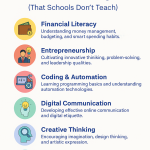7 Powerful Reasons Why Interactive Learning Boosts Kids’ Success

7 Future Skills for Kids in Malaysia
7 Powerful Reasons Why Interactive Learning Boosts Kids’ Success

7 Future Skills for Kids in Malaysia
Traditional learning methods often rely on memorization and repetition—but for kids, that can quickly become boring. To truly spark curiosity and motivation, many educators and parents are turning to interactive fun learning. It’s not just about making things entertaining; it’s about helping children engage, explore, and enjoy the learning process.
Here’s how you can make learning both meaningful and exciting for children of all ages.
What is Interactive Fun Learning?
Interactive learning involves active participation rather than passive observation. It transforms lessons into experiences—using movement, games, creativity, and collaboration to help kids understand and remember new concepts.
Instead of worksheets and lectures, think building, role-playing, storytelling, coding, and experimenting. The key is that kids are doing, not just listening.
5 Creative Ways to Bring Fun into Learning
1. Turn Lessons into Games
Use flashcard competitions, scavenger hunts, or quiz-based challenges. Simple game mechanics add excitement and turn review sessions into friendly competitions.
2. Combine Learning with Art
Let kids express what they’ve learned through drawing, crafting, or building with materials like LEGO or clay. It’s a great way to connect ideas with creativity.
3. Explore Through Storytelling and Role-Play
Create characters and act out lessons—be it historical events, science experiments, or even business transactions in a mini shop. This brings abstract ideas to life.
4. Use Technology the Right Way
Digital tools like educational apps, interactive videos, and coding games (like Scratch or Tynker) allow kids to learn at their own pace while staying engaged.
5. Get Hands-On with Real-Life Scenarios
Set up a pretend grocery store to teach money skills, plant seeds to learn biology, or cook a recipe to understand measurements and following instructions.
Why It Works
Interactive fun learning supports multiple learning styles, improves focus and retention, and builds confidence. It turns every lesson into an adventure—one that children look forward to, not avoid.
It also helps develop important soft skills such as teamwork, communication, critical thinking, and adaptability.
Bringing It Home or to the Classroom
Whether you’re a parent, tutor, or teacher, you don’t need a huge budget or fancy materials. What you do need is a mindset shift—seeing learning as an experience, not just a task.
Start with one idea a week, observe how the child responds, and gradually build a library of interactive learning activities they truly enjoy.
Learning doesn’t have to be serious all the time. In fact, the more fun and interactive it is, the more likely kids are to stay curious and inspired. With the right approach, every child can fall in love with learning—and that’s the first step toward lifelong success.




